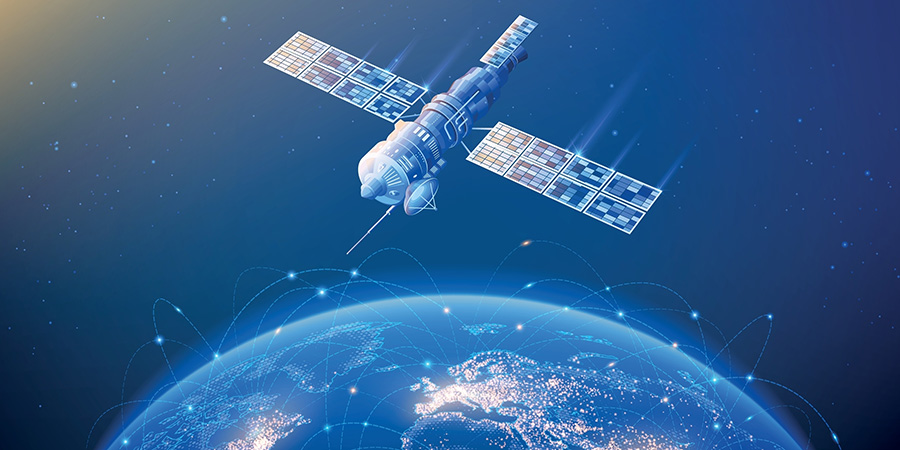In today’s era, the world has become increasingly reliant on digital connectivity, evolving from convenience to a necessity.
However, staying connected remains a challenge, particularly when terrestrial networks fail. Satellite communications step in as critical backups for terrestrial networks, further bridging the digital divide and connecting remote communities.
The satellite internet market has experienced remarkable growth, surging from USD 4.56 billion in 2024 to USD 5.12 billion in 2025, according to Research and Markets. This growth is expected to continue, with projections reaching USD 9.39 billion by 2030 at a compound annual growth rate (CAGR) of 12.78%, driven by evolving consumer demands.
As the world’s dependence on uninterrupted connectivity increases, satellite communications are set to play a critical role in providing resilient communication during emergencies.
Latest: Syria’s Al-Ikhbariya Joins Es’hailSat’s Video Hotspot
Satellites as Communication Lifelines
Back in 2022, Mohammad Marashi, SVP, Product and Strategy, Networks, SES, predicted a “rapid growth in mobile data usage,” advocating for “multi-orbit satellite services” to meet this demand and align with “digital inclusion requirements.”
Today, the satellites orbiting above the Earth remain unaffected by ground-level disruptions, unlike fiber optic cables or cellular towers, making them indispensable for emergency response and maintaining connections in underserved regions.
These vital communication lifelines provide high-speed, low-latency internet service globally, with modern advancements boosting their capabilities.
Beyond bridging the digital divide, satellites are being integrated into critical operations, particularly in areas where real-time communication is essential.
As Mohammed Al Sayed, Executive Director of Sales at Es’hailSat, pointed out, “VSAT connectivity, disaster recovery backups, and broadcast services,” are necessary to maintain communication during disasters.
The advent of artificial intelligence (AI) is further advancing satellite communications, improving satellite image analysis efficiency by up to 70%, according to Gitnux. Approximately 65% of satellite data providers have integrated AI to automate data processing, with AI algorithms detecting and classifying space debris with 85% accuracy. Furthermore, satellite communication companies using AI have reported a 25% reduction in operational costs, underscoring the significance of AI-driven solutions in optimizing resource allocation.
Related: Red Flag: Protection of Navigation Satellites Critical
When Terrestrial Networks Fail
As the world becomes more reliant on constant communication, satellite networks have emerged as a critical backup to terrestrial systems, ensuring connectivity remains intact amid compromised ground infrastructure.
Terrestrial network failures expose the vulnerabilities of ground-based communication infrastructure that can affect millions of people. Traditional phone systems depend on cellular towers and cables, which can be damaged or destroyed during natural disasters or targeted attacks.
Earthquakes, wildfires, and severe weather events can disrupt terrestrial networks, cutting off significant communication channels. For instance, the earthquake that struck Haiti in 2010 damaged most of the country’s telecommunication infrastructure, while the remaining operational cell towers were overloaded with calls.
In 2022, the Africa-Asia-Europe-1 (AAE-1) and SEA-ME-WE-5 (SMW-5) submarine cables suffered cable cuts, disrupting internet connectivity in East Africa, the Middle East, and South Asian countries, including Pakistan, Somalia, Djibouti, and Saudi Arabia. This disruption underscores the critical need for backup solutions to maintain secure communications.
The Middle East has faced further challenges due to the fragility of submarine cable networks, which carry 95% of international data. In February 2024, four major submarine cables in the Red Sea were damaged, affecting up to 70% of data flow between Asia, Europe, and the Middle East. The damage forced telecommunication providers to reroute traffic, underscoring the region’s heavy reliance on digital infrastructure to meet connectivity demands.
More recently, a massive blackout across Spain severely impacted telecommunications, with Vodafone Spain operating at only 70% capacity through its backup generators.
Also Read: Satellite Internet to Bridge Connectivity Gaps Across Jordan
Recent Advancements in Satellite Communications
Recent advancements and significant investments in satellite communications are securing uninterrupted connectivity across the world.
In 2023, Saudi Arabia announced a USD 266.5 million investment to establish its first satellite manufacturing company, positioning the Kingdom as a regional hub for space technology and innovation.
Meanwhile, the UAE government awarded Yahsat a USD 5.1 billion contract to provide satellite capacity and managed services over 17 years, underscoring the significance of satellite communications in the country’s development plans.
In March 2025, Space42’s mobility arm, Thuraya, introduced Thuraya One, an Android 14 smartphone integrated with satellite and cellular connectivity, enabling users to stay connected beyond traditional network coverage. By combining 4G and 5G capabilities, Thuraya’s satellite network aims to provide reliable, consistent, and secure coverage, particularly in underserved regions.
Moreover, recent partnerships are expanding satellite broadband availability in the Middle East, with Eutelsat collaborating with Orange Jordan to make satellite broadband capacity accessible to more users.
For Ari Banerjee, Senior Vice President, Strategy, Netcracker Technology, “LEO satellites offer an exciting and affordable option to bridging the digital divide, filling mobile coverage gaps and equipping diverse industries with high-quality and mission-critical communications anywhere in the world.”
Related: Oman Set to Boost Nationwide Satellite Connectivity
Final Thoughts
As the industry evolves, the focus on reliable and resilient connectivity solutions has never been greater. Satellite networks are emerging as indispensable components, offering critical capabilities that ensure uninterrupted communication even when terrestrial infrastructure is compromised.
The growing dependence on digital infrastructure underscores the urgency of integrating satellite communications to safeguard important communication channels around the world.
Read More:
The Challenges and Limitations of LEO Satellites
From Doha to Orbit: Qatar’s Role in Global Space Spectrum Protection Grows
Bahrain Made: The First AI-Advanced Nanosatellite in the Middle East










